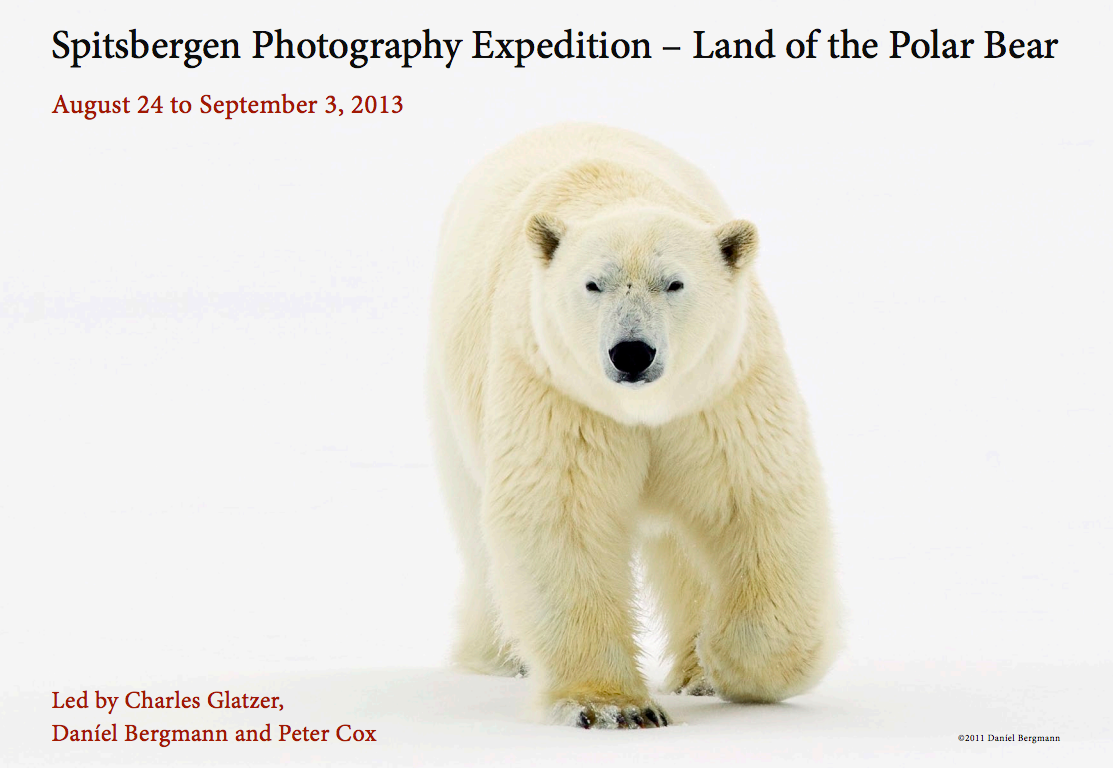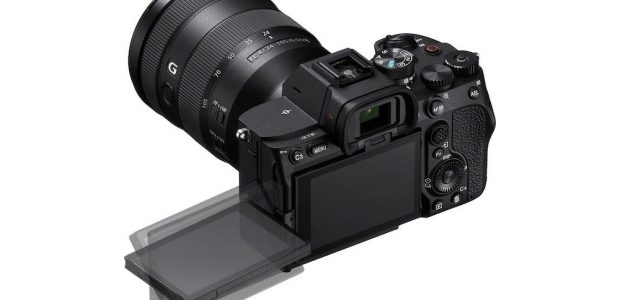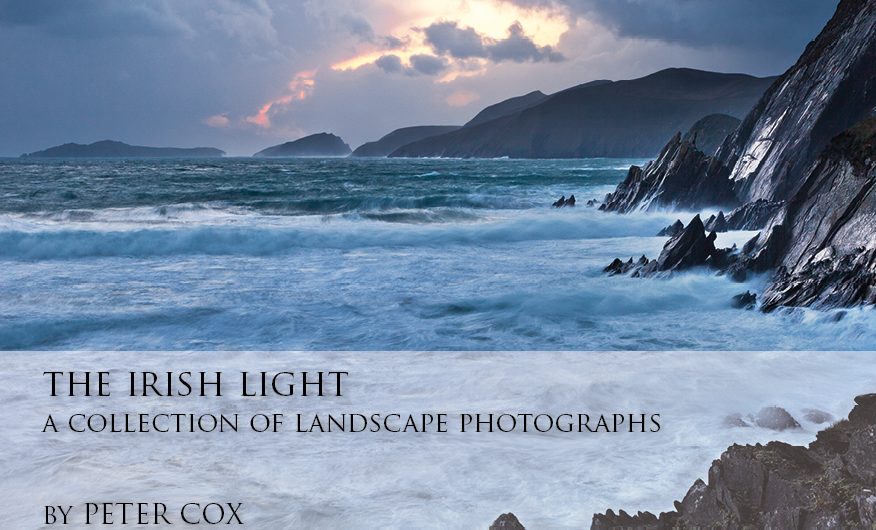

The Irish Light Front Cover
In 2012, I self-published my first book of landscape photographs. I raised the funds to do this via the crowd-funding website Kickstarter.com.
I needed $11,000 to produce 1,000 copies. By its completion, the project had raised $39,383 from 341 backers – 358% of the original goal. Due to the success of this campaign, I increased the size of the book from 112 to 128 pages, printed 3,000 copies and produced an additional luxury leather-bound edition.
The fundraising was so successful that the book was profitable before it ever went to press, and I’m going to share the details of how this was achieved below.
Background
What photographer, amateur or professional, hasn’t dreamed of seeing their work published in a coffee-table book? It was certainly a dream of mine, and in 2009 I made some enquiries to publishers in Ireland to see if I could make it happen. I got a couple of responses that were polite rejections, saying that due to the state of the market and the economy in general, they weren’t looking to do anything in the ‘fine art’ segment at the time. However, they said nice things about my photography, and that I should get back in touch when the climate improved.
That’s more or less how I left it, putting the idea on the back burner and moving ahead with other projects. One of those was the opening of a retail photography gallery in early 2011.
Apparent Demand
Running a photography gallery is no easy thing. Prints are definitely a luxury item. They require effort on the part of the customer to locate a place for them on their wall, and then to hang them. Often, the customer has no space on the wall in the first place!
As such, there were lots of people who walk into the gallery, love the work, but end up not buying because they’re either not sure they have the space, or they know they don’t. Some people also enjoy photography, but prefer not to hang prints on their wall.
It became obvious that I needed to have some sort of product that would appeal to those people. What better than a coffee table book? By this time, two friends of mine had already self-published similar books and had met with some success. The idea of self-publishing appealed to me, as I would get all the profits and would have total freedom to produce the book as I wanted to. To me, the big advantage of using a publisher is the marketing work they’ll do, as well as arranging the distribution. I wasn’t particularly concerned with either of these things at first. I felt that the book would sell well through the gallery – more than well enough to justify producing it, even if it never sold anywhere else.
I was getting ready to apply to my bank for a loan to cover the cost of printing (roughly €8,000). Right around then, someone I follow on Twitter shared a link to a project of a different sort that was being funded via Kickstarter. I clicked through and was immediately fascinated by the model, never having heard of it before.
Kickstarter
Kickstarter projects work as follows: You create a project and set a funding goal and deadline. Backers pledge money to the project in exchange for rewards (generally for variants of the product you’re funding). Their credit cards are authorized for the pledged amount, but not charged yet.
If your goal is met by the deadline, your project is funded and all the backers’ cards are charged immediately. After a few days in escrow, the funds are transferred to you via Amazon Payments (minus Kickstarter’s 5% fee, plus whatever Amazon Payments takes – about 3%).
If the project doesn’t meet its goal, nothing happens. This is what makes it such a great way to fund projects. There’s very little risk on the part of the backer – they only pay if the project succeeds.
As a project creator, there are many advantages. You get to see if your project is viable before sinking much money or effort into it. If you don’t meet your funding goal, then quite likely the product wouldn’t make a profit anyway – either because the product isn’t very interesting to the market, or because you’re not competent to properly market it. It’s a great way to market-test your idea!
At this point in time, Kickstarter only supports projects originating from the US or the UK. If you don’t live in one of those countries, then you can’t create a project. I was able to run one despite living in Ireland as I have retained a residence and bank account in the US, having lived there for ten years.
My Project
It took me about a month to put my project together. Most of that time was spent developing the description, the script for the video and the reward levels. The completed project remains visible on Kickstarter – I encourage you to check it out.
The book was designed in roughly the same period of time. I was able to put it together so quickly because I didn’t have to shoot any material specifically for it. I took the best 90 photographs from my portfolio to date and laid them out on a table. I saw right away that there was roughly a 50/50 split between landscapes and seascapes, so that was the logical way to arrange the book. I approached each pair of facing pages as a panel, and picked images that complement each other well. I then rearranged the general order of pages into something that I thought flowed well. The book was designed and laid out in InDesign.
I thought long and hard about who I could get to write the foreword, but the choice became obvious as I was writing my own introduction. Joe Cornish was a huge influence on my photography, particularly right when I was starting out. I don’t know Joe well, having only met him once at a talk he gave some years ago. However, I got in touch with him and sent him a copy of the finished layout. It was a huge compliment when he came back to me and agreed to write the foreword.
Setting the Funding Goal & Deadline
It’s important when setting your funding goal that you ask for just enough to create the mimimum viable product. That’s the lowest amount you need to produce something the backers will want. If you fail to reach your goal, you get nothing. However, once your goal is reached, the project stays live and can be backed until the time limit expires. That means you can get more (sometimes a lot more) than you asked for. Most projects set up “stretch goals” which unlock improvements to the product if reached. These are informal goals – if they aren’t reached it doesn’t impact how much money you receive for the project.
If you can do the bare essentials for $10k, but exactly what you’ve always wanted for $50k, it’s best to ask for $10k and hope to raise the rest via stretch goals if the project goes really well.
For my project, I set my funding goal for $11,000. This was enough to cover the cost of printing 1,000 copies of the book after the fees were paid. To be honest, I didn’t expect to raise much more than that, but when I hit my goal so early I added stretch goals of $25,000 (add 16 pages to the book, raise the print run to 3,000 copies) and $35,000 (every backer gets a free 9×6″ print along with their book). These definitely helped push the project on to its final tally of just shy of $40,000.
The deadline is also an important consideration. Kickstarter recommends 30 days, and that’s what I chose. Longer than that and you encourage procrastination among potential backers, and shorter than that limits your time to promote.
The Video
My Kickstarter Project Video
The video is a very important part of the project. It’s your elevator pitch. Most people will watch that first, and if it doesn’t interest them, go no further. The video needs to present you as a person, and convince the prospective backer that (a) this is something they want to invest in, and (b) that you’re the right person to bring it to completion.
Your script is very important, and you must be enthusiastic. The backer is investing in you as much as they are in the end product. I shot mine on a Canon 5D Mk II with a home-made teleprompter, and cut in clips of me working in the landscape from a different project.
You can see the statistics on my project’s video below:

Kickstarter Video Plays
As you can see, almost half the plays were to completion – about 4,200 in total. That works out to about an 8% conversion rate – 8% of the people who watched it all the way through pledged to the project. That’s a powerful statistic!
Reward Levels
Your reward levels are also very important. Kickstarter has great resources available showing statistics on what works and what doesn’t.
The most popular pledge level across all projects is $25, and the average pledge is $70. I had that in mind when constructing my own reward structure, and the $65 level (which got the backer a copy of the finished book, shipped outside of Ireland) was by far the most popular on my project with 155 backers and 27% of the overall money raised.
The higher pledge levels got prints of my work in various sizes, along with the book. The $1,000 level included a one-to-one workshop. To see the pledge levels in detail, take a look at the project page itself.
Below is a graph of the pledge levels versus number of backers and percentage of money raised on my project. I’ve consolidated similarly-priced reward levels, as the main difference in them is postage (the low end of each range was for Irish backers, the upper end for foreign backers).
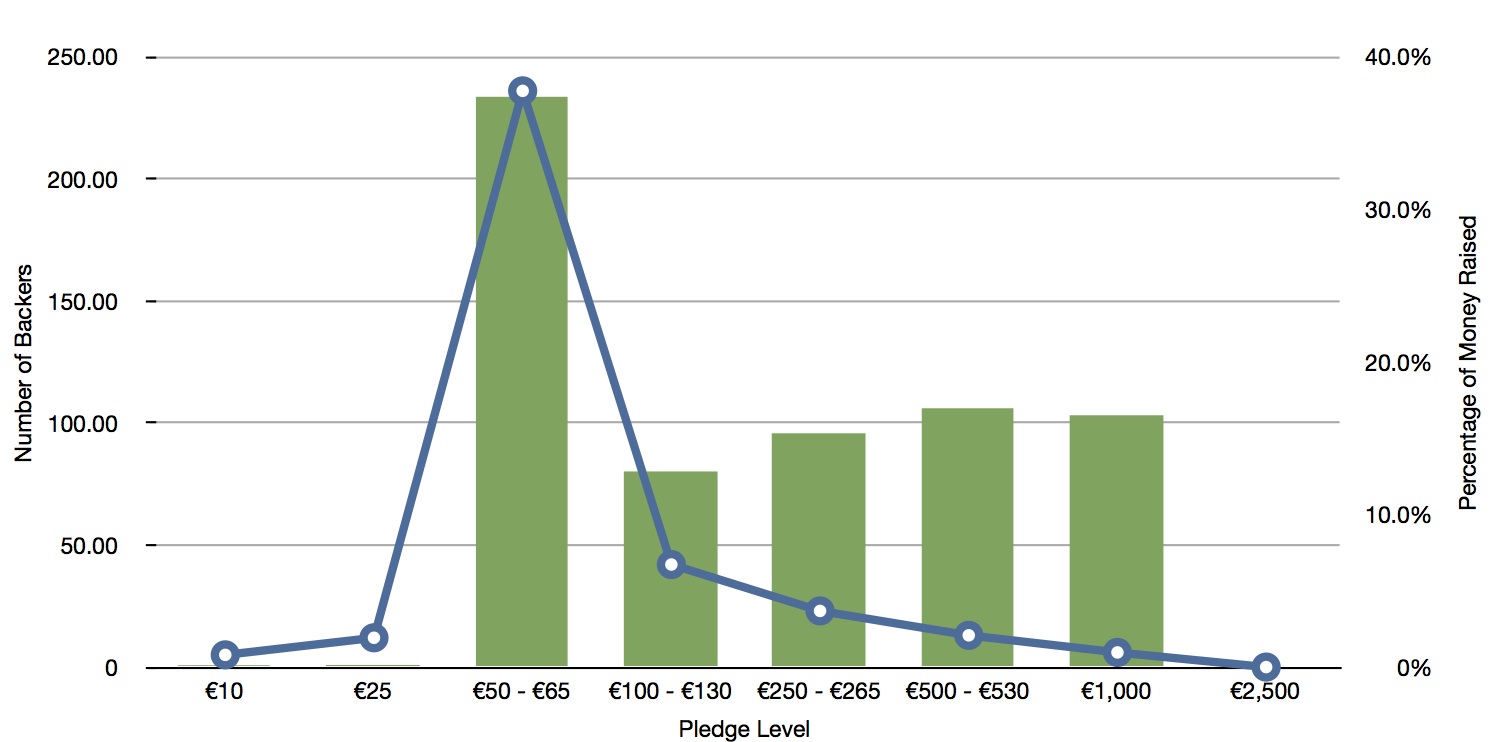
Pledge Level vs. Number of Backers and Percentage of Money Raised
Blue Line – Number of Backers. Green Bars – Percentage Raised.
I priced my reward levels so as to give real value to the backers. Prices worked out to be less than the eventual retail cost of the book and prints at each level. I think this helped the project be as successful as it was – there’s already a sense of connection the backers feel by making something like this happen. Adding good value on top of that is a powerful thing.
You must be careful when setting the reward levels. Keep in mind what your costs are, and what the cost of shipping will be. Shipping in particular can be a killer. If I had been better prepared when setting up this project, I could have saved over 50% on my shipping cost (which was significant).
How the Project Ran
You can see the general course of the project in the below graphic, which shows funding progress over time. This is pretty typical for most Kickstarter projects – there’s a steep rise at the beginning which flattens out during the middle period and then another steep rise at the end. The green horizontal line just above $10k represents the funding target.
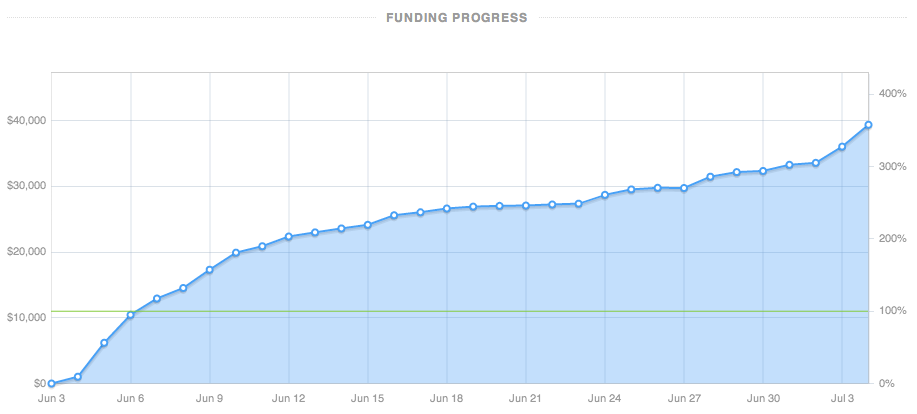
Funding Progress Over Time
You see that the initial rise started to top out around June 7, at which point Michael posted a plug for the project here on LL – that accounts for the re-steepening of the curve around June 8 (thanks Michael).
My publicity for the project was mainly through social media – namelyFacebookandTwitter(and the aforementioned plug here on LL). Social media definitely works, if used properly. I made sure to ask people to reshare the announcement, and every backer received a personal thanks from me, along with a request to continue to spread the word through their networks (on- and off-line).
I attribute hitting the target number so early to pent-up demand for a book among people who follow my photography. In fact, I didn’t even get around to sending a notice to my mailing list that the project was happening until it was already at 60% of the target! Clearly this project represented something of a “low hanging fruit”. I have plans to run another project in the next year or so. It will be very interesting to see how that compares with this one.
Below you can see where the pledges came from. Over a quarter came from Kickstarter itself – these are people who were browsing for projects to back and came across mine.
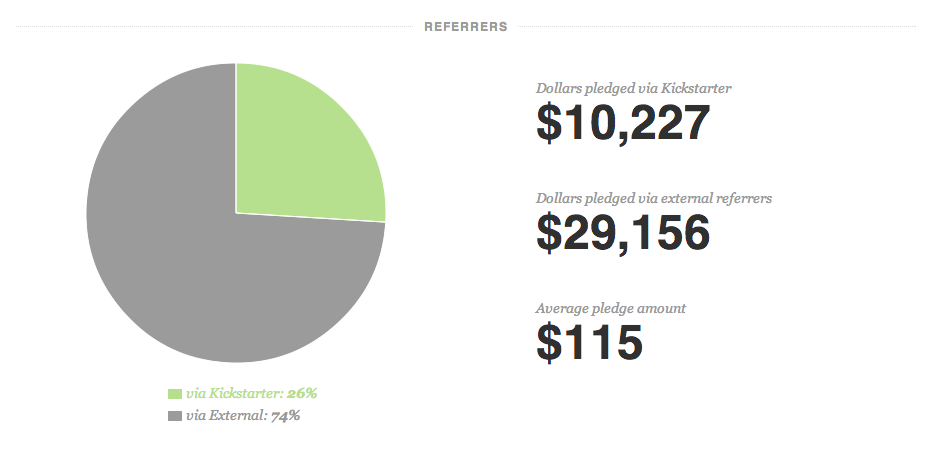
Referral Sources – Overall
And here is a list of the top ten referrers, sorted by percentage of money raised. You can see that referrals from LL is the largest single source outside of direct traffic (thanks again, Michael!). Direct traffic are those people who copied and pasted the link into the address bar from some other source, rather than clicking on it.
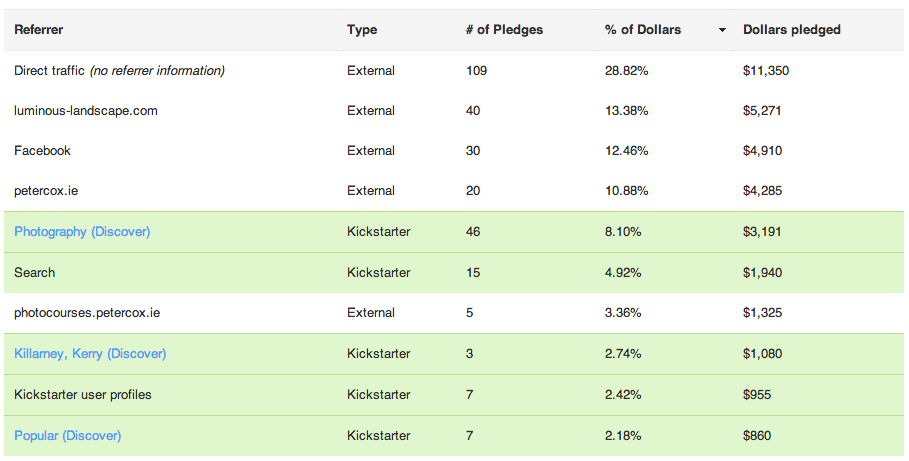
Referral Sources – Top 10
Green lines represent referrals from within Kickstarter itself.
Conclusion
The project earned almost $40,000 and allowed me to print three times the initial planned run with confidence – which means the unit cost is lower than I originally planned. Now, just over half a year later, over half the run is sold and I’m expecting to have to re-print at the end of the summer season. If you’d like a copy for yourself, it can beordered directlyfrom my website. If you’re a distributor or a book seller, you cancontact meto discuss options.
Fueled by the success of the project, I was able to mount a PR campaign which resulted in significant coverage of the book in the national press in advance of the Christmas buying season. This generated orders for the book from shops nationwide and resulted in the book being picked up by the two major distributors in Ireland.
Kickstarter is an excellent tool for the self-publisher. A successful campaign means you can publish your book without significant up-front cost. It also generates enough interest to fuel publicity –“Local photographer makes good” at the very least, which will drive further sales.
However, it’s a lot of work. Really a lot of work. I thought I knew how much work it was going to be, but I was wrong. You should also be aware that all Kickstarter projects stay on the site in perpetuity. Even ones that are embarassing failures. The thought of that – not being able to quietly sweep this under the rug if it failed – was an additional incentive for me to see this one succeed.
February, 2013
Update – 15/1/2014
I’m delighted that this article has helped and inspired others to self-publish their own books. One question that I’m frequently asked is where I printed the book. It seems many of you look at the on-demand printers on the web, like Blurb, and are not getting good pricing.
I printed my book through Castle Print in Ireland. I found them very reasonable in price and I was able to be present during the printing process. I recommend you find a lithographic printer local to you and go talk to them.
Do be aware that you need to print many copies for the economics to make sense. The unit price will always be prohibitively expensive for small runs. Generally you start getting into sensible figures when you’re printing 1,000 copies or more. Of course, this means a high printing cost in total, but the unit price will fall to something where you can actually make a profit when selling the book.
Last summer, I sold out the 3,000 copies of the initial print run and reprinted a further 5,000. I used the same printers and the results were even better than the first time around.
I hope this is helpful! Good luck with your self-publishing!
Peter Cox
Peter Cox is a professional landscape photographer and educator living in the beautiful south-west of Ireland. He runs regular photography tours in Ireland and abroad, including an upcoming trip in August 2013 to the Svalbard Islands with Daníel Bergmann and Chas Glatzer. His prints can be purchased online , or in person at his photography gallery in Killarney, Co. Kerry, Ireland. You can also follow him on Facebook.
Updated: March 12, 2015
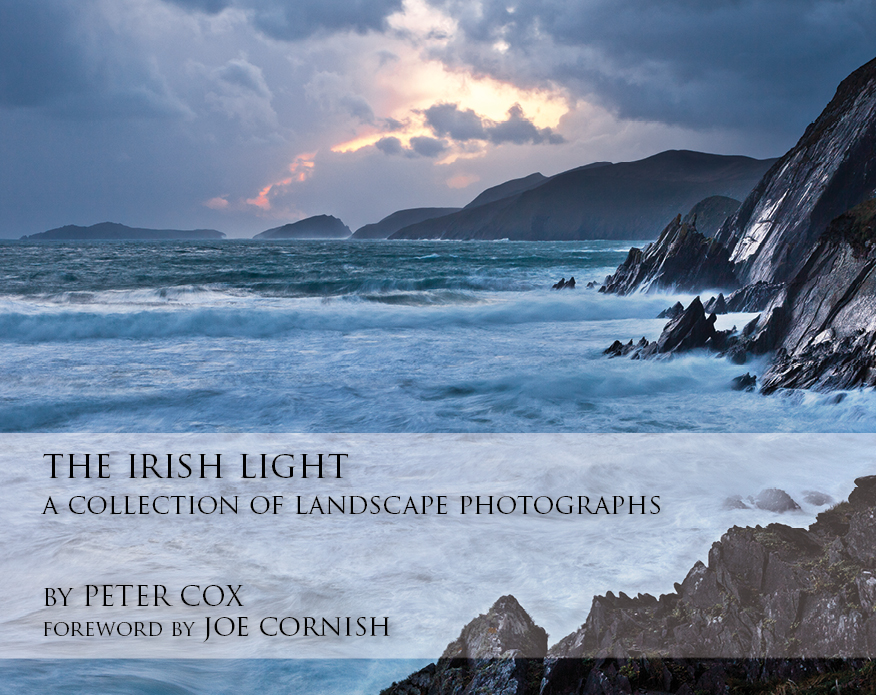
Lorem ipsum dolor sit amet, consectetur adipiscing elit, sed do eiusmod tempor incididunt ut labore et dolore magna aliqua. Ut enim ad minim veniam, quis nostrud exercitation ullamco laboris nisi ut aliquip ex ea commodo consequat. Duis aute irure dolor in reprehenderit in voluptate velit esse cillum dolore eu fugiat nulla pariatur. Excepteur sint occaecat cupidatat non proident, sunt in culpa qui officia deserunt mollit anim id est laborum.
Lorem ipsum dolor sit amet, consectetur adipiscing elit, sed do eiusmod tempor incididunt ut labore et dolore magna aliqua. Ut enim ad minim veniam, quis nostrud exercitation ullamco laboris nisi ut aliquip ex ea commodo consequat. Duis aute irure dolor in reprehenderit in voluptate velit esse cillum dolore eu fugiat nulla pariatur. Excepteur sint occaecat cupidatat non proident, sunt in culpa qui officia deserunt mollit anim id est laborum.
Lorem ipsum dolor sit amet, consectetur adipiscing elit, sed do eiusmod tempor incididunt ut labore et dolore magna aliqua. Ut enim ad minim veniam, quis nostrud exercitation ullamco laboris nisi ut aliquip ex ea commodo consequat. Duis aute irure dolor in reprehenderit in voluptate velit esse cillum dolore eu fugiat nulla pariatur. Excepteur sint occaecat cupidatat non proident, sunt in culpa qui officia deserunt mollit anim id est laborum.
Lorem ipsum dolor sit amet, consectetur adipiscing elit, sed do eiusmod tempor incididunt ut labore et dolore magna aliqua. Ut enim ad minim veniam, quis nostrud exercitation ullamco laboris nisi ut aliquip ex ea commodo consequat. Duis aute irure dolor in reprehenderit in voluptate velit esse cillum dolore eu fugiat nulla pariatur. Excepteur sint occaecat cupidatat non proident, sunt in culpa qui officia deserunt mollit anim id est laborum.
You May Also Enjoy...
2021 Camera of the Year and Manufacturer of the Year, and camera body roundup (below $5000). Plus a note about holiday camera availability.
FacebookTweet 1.) Holiday Camera Availability and Sales If you are thinking about giving an interchangeable lens camera as a gift this holiday season, there has

